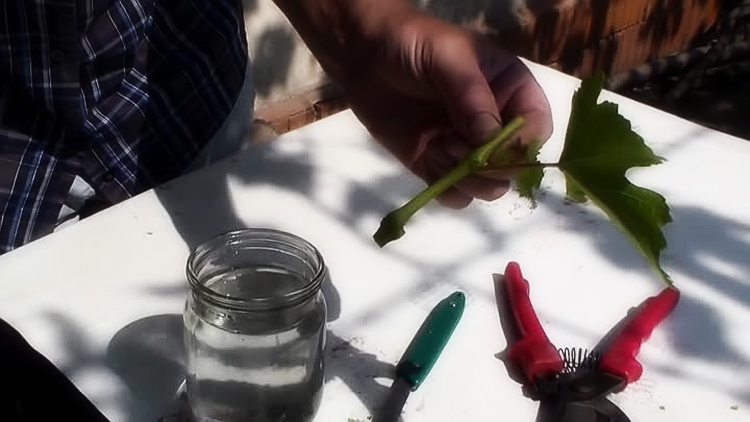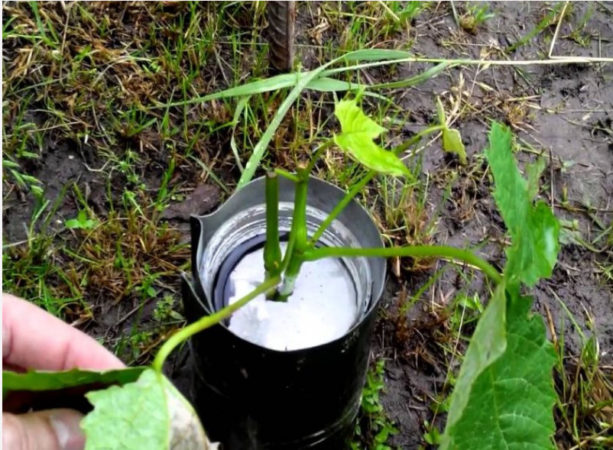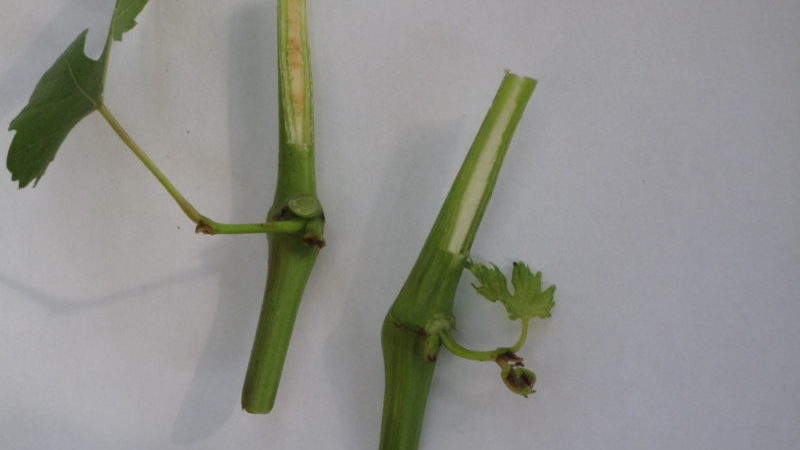A guide to propagating grapes with green cuttings in summer
To expand the area of the vineyard, as well as to renew the old favorite varieties, there is a method of propagating grapes with green cuttings. This simple and common method is easy for even beginner growers to master. It is important to carry out the procedure correctly, observing the technology of cutting, rooting and planting the source material. How grapes propagate by cuttings in summer, we will tell in the article.
The content of the article
Is it possible to propagate grapes with green cuttings in summer
Cuttings of grapes for cultivation are carried out not only in the fall, but also in the summer.
Summer propagation of culture is widely used both in large nurseries and in personal plots. This is the most painless method for the plant. In addition, it does not require the expense of funds, since parts are used as planting material that are removed in the process of breaking off green shoots.

It can be difficult to get a good variety of seedlings, because the cost of a new item can go up to $ 50-100. Therefore, you have to face the need to obtain your own high-quality planting material.
The technology of summer cuttings was developed by Dr. Selhoznauk Malykh G.P. in the second half of the 20th century. It has spread widely due to its high survival rate and economy - up to 10 cuttings are obtained from one shoot, which, with proper care, by next spring become full-fledged seedlings for planting in a permanent place of growth.
Advantages and disadvantages of summer cuttings

Obtaining new independent plants from individual vegetative organs of a plant or their parts has a number of advantages:
- The possibility of independent rapid reproduction of culture at home.
- Preservation of varietal characteristics of the mother bush: taste and external qualities, productivity, ripening time.
- Breeding any, even rare grape variety without harming the mother plant.
- Increasing the amount of harvest in a budgetary way.
- Plants begin to bear fruit earlier than those grown from seeds.
- Possibility of restoring vineyards affected by frost or disease.
- The simplicity of a method that does not require specific skills, unlike vaccinations and growing from seeds.
- By the time of planting, a strong root system is formed, which greatly simplifies the process of engraftment.
- The ability to control how the root system is formed and the plant develops.
The disadvantage of this method is that when propagated by cuttings, the seedling usually ready to board only in autumn, so it may not survive the winter in the open field.
When to cut grapes in summer
Summer is the most active period for gardeners. It is at this time that it is best to deal with the beautification of the vineyard and the cultivation of bushes. After all, the length of daylight hours and warm weather significantly accelerate the process of root formation in young plants.
The most favorable moment for green cuttings is late May - early June, when the grapes begin to bloom. By this time, the foundations of new shoots formed in the current year are in a semi-lignified state.
The plant has accumulated a sufficient amount of growth hormones, nitrogen, phosphorus, potassium, carbohydrates, contributing to the better development of cuttings and their further survival.
Auspicious days
In the waning phase of the moon, the plant juices sink to the roots, and in the growing phase they rise to the aerial part. In this regard, experienced growers synchronize the summer grafting of the culture with the lunar calendar, which indicates auspicious days for the procedure.
At this time, the plant develops more actively, therefore, the percentage of survival of green cuttings increases. Their harvesting is carried out only in the phase of the growing moon, closer to the full moon.
Auspicious days:
- May - 29;
- June - 1-4, 21-31.
Favorable days for planting cuttings:
- in July - 22-25;
- in August - 19-22.
Selection and preparation of green cuttings

The survival rate of the cuttings and its further development depend on the competent choice of the shoot. Even during spring pinching or pruning, they leave several shoots for reproduction and wait until the lower leaf ages - it acquires a rich green color, becomes more rigid.
These signs indicate a sufficient accumulation of nutrients in the plant.
Procedure sequence:
- The best shoots are carefully selected.
- The top is cut off at once: it does not take root and rots. Take only the middle and lower part of the shoot with a diameter of 7-12 mm in vigorous varieties and 5-9 mm in medium-sized ones.
- Shapes with 2-3 eyes are cut. The procedure is performed in cloudy weather or in the evening.
- The first cut is made at an angle of 45 ° below the knot by 5 cm, the second is a straight cut, 2 cm above the upper knot.
- If the shank has two eyes, the lower sheet is cut off, the upper one is left.
- In a cutting with three eyes, the lower leaf is removed, and the middle and upper ones are slightly shortened. This is necessary to reduce the evaporation area.
It is important that during this time the air temperature does not drop below + 20 ° C, and the light is diffused. Such conditions will greatly speed up the formation of roots.
Reference. To accelerate root formation, the prepared shanks are placed in a Heteroauxin solution (½ tablet per 1 liter of water) for 8-10 hours, immersed in ⅓ of their length.
Ways to root them
Let's consider several ways how to propagate grapes by cuttings.
In water

Procedure:
- After the stimulating solution, the cuttings are immersed in a glass jar or other transparent vessel filled with boiled chilled water for 3 cm. First, cotton wool is placed on the bottom with a layer of 2 cm, 2 crystals of potassium permanganate and a small piece of charcoal are added.
- The vessel is placed on the windowsill. If necessary, add water to the original level (approximately every 3 days). To slow down the evaporation of water and increase the humidity of the air, a plastic bag is put on top.
- After 2 weeks, the roots will already be visible. If they did not appear, but shoots began to form from the buds, they are removed. As soon as the roots reach a length of 3 cm, they are planted in the soil, otherwise they will die due to a lack of oxygen.
In the ground
Algorithm of actions:
- Any containers are prepared in advance: containers for seedlings, cut plastic bottles with a volume of 2 liters or specially knitted boxes. When choosing, take into account the depth, which should be from 40 to 50 cm.
- Then sand and earth are mixed in equal parts and poured into a box (layer thickness is approximately 10 cm). In such a mixture, it is easier for young roots to grow. Sand 4–5 cm high is poured on top and everything is well moistened.
- The stalk is buried 2-3 cm so that it does not touch the surface of the earth. After planting, abundant watering is carried out, covered with glass or transparent film. To accelerate root formation, it is important to create a high air humidity, therefore, once every 5 days, the cuttings are sprayed with warm water using a spray bottle.
- The mini-greenhouse is located in a shaded place outside or in a bright room with an air temperature of + 22 ... + 25 ° C.If all the necessary conditions are met, in 10-12 days, the rudiments of roots will begin to form, and in a month the shoot will grow.
- All this time, water is regularly watered and the shelter is gradually removed (start from 15 minutes and bring to the whole day) so that the plant gets used to external conditions. By autumn, the growth will be 50 cm, a well-developed fibrous root system will be formed
- 1-2 weeks after removing the shelter, the plant is planted in a permanent place (frost-resistant varieties) or the box is transferred to the basement before spring planting (not frost-resistant varieties).
In sawdust
Procedure:
- Sawdust of any tree species is placed in a container and poured with boiling water.
- After the water has cooled, they are washed, large shavings, tree bark are removed and squeezed.
- Then sand is added, mixed and transferred to a container designed for planting cuttings (the bottom should be with drainage holes).
- The cuttings are immersed 2-3 cm into the substrate, taking into account the distance between them of 10 cm and watered.
- The container is covered with foil and placed in a well-lit place with an air temperature of at least + 25 ° C.
- Water once a day, the excess liquid formed in the pan is drained. Roots are formed within 2 weeks.
This rooting method allows you to achieve a quick result, but with the formation of roots, it requires a mandatory transplant into the ground.
Planting ready-made cuttings

Cuttings with a fully formed root system are planted in the ground in the fall in early September or next spring in early May.
When planting in autumn, the seedlings are carefully covered, protecting them from the upcoming winter frosts.
Sequence of work:
- Pits 70 × 70 × 70 cm in size are prepared, the distance between them is left taking into account the recommendations for a particular variety.
- The soil selected from the pit is mixed in equal parts with humus and the depression is covered by ¼ part.
- Next, a nutrient mixture is prepared from 3 liters of ash, 300 g of potassium fertilizer and superphosphate, a small amount of soil. The mixture is laid out in a pit with a layer of about 10 cm.
- A layer of soil is poured on top, a mound is formed on which the seedling is placed.
- The roots are carefully laid out on the sides of the mound and sprinkled with soil no higher than the level of the first developed eye.
- The ground around the plant is compacted and watered with 2 buckets of water.
- A support for a developing plant is installed nearby.
Features of cuttings depending on the region
Most often, grape propagation by green cuttings is used in the northern regions of Russia with short summers and frequent early frosts.
In order for a full-fledged root system to form, in different regions of the country, the germination of cuttings is started in due time:
- in the southern regions of the Russian Federation - in late January - early February;
- in the middle lane and the Moscow region - in late February or early March;
- in Siberia and the Urals - in the second half of March.
Depending on the grape variety
Cuttings of almost all grape varieties take root easily.
Alyosha is distinguished by a high degree of survival, Arcadia, Delight, Riesling, Pomegranate, etc.

In the southern regions of Russia (Krasnodar, Stavropol Territory), more susceptible to phylloxera (grape root aphid), it is more expedient to grow varieties resistant to this dangerous pest: Moldova, In Memory of Negrul, Alpha, Aurora Magarach, Firstborn of Magarach, etc.
Unpretentious and frost-resistant varieties Odessa grapes Muscat, Pridonsky, De Codru, Alexandria suitable for cuttings in the northern regions of Russia.
Further care
Growing grapes from cuttings requires a lot of attention, especially in the first year. Care includes:
- weeding and watering;
- regular loosening of the soil;
- garter vines;
- treatment of seedlings from diseases;
- feeding.
Young plants are watered once every 2 weeks. To do this, several buckets of water are poured right under the bush.
The land near the cuttings is weeded as the weeds grow, they are loosened once a week.This is necessary to provide the roots with air. Top dressing is used only organic, such as humus or compost. They contain a sufficient amount of nitrogen, which prevents yellowing of the leaves. Fertilizers are applied up to 4 times a year.
Tips from experienced winegrowers
The main recommendations of experienced winegrowers for propagating grapes with green cuttings in summer:
- The planting material is planted in the ground so that the first buds are 5 cm below ground level.
- Do not over-water the seedlings. Watering is carried out 2 times a month, and is stopped during the rainy season.
- Stepchildren break out all over the vine. If this is not done, the bush may die.
- Some aspiring winegrowers save on the purchase of expensive processing preparations, but this is wrong. It is important to use modern fungicides on time.
- Young plants are covered for the winter.
Conclusion
Growing grapes using cuttings is simple, just follow all the tips and tricks.
It is important not to neglect the treatment of bushes from diseases and pests, as well as to feed the plants in a timely manner. Painstaking work will be rewarded with a large and tasty harvest.